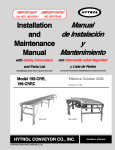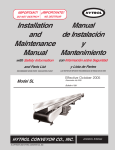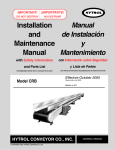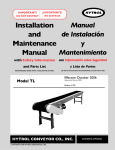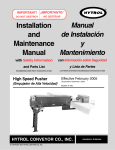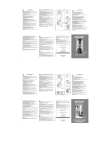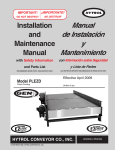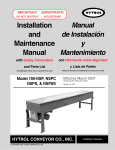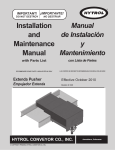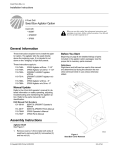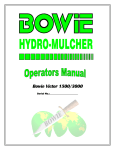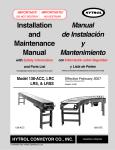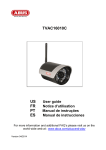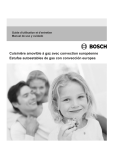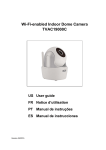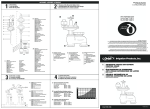Download 25/26 CRR Manual - Hytrol Conveyor Company, Inc.
Transcript
IMPORTANT! ¡IMPORTANTE! DO NOT DESTROY NO DESTRUIR Manual Installation de Instalación and y Maintenance Mantenimiento Manual with Safety Information con Información sobre Seguridad and Parts List y Lista de Partes RECOMMENDED SPARE PARTS HIGHLIGHTED IN GRAY LAS PARTES DE REPUESTO RECOMENDADAS SE RESALTAN EN GRIS Model 25/26-CRR Effective February 2012 Bulletin No. 639 25/26-CRR HYTROL CONVEYOR CO., INC. © COPYRIGHT 2006–HYTROL CONVEYOR CO., INC. Jonesboro, Arkansas Table of Contents 2 Tabla de Contenido Warning Signs . . . . . . . . . . . . . . . . . . . . . . . . .3 Señales de Advertencia . . . . . . . . . . . . . . . . . . .3 INTRODUCTION Receiving and Uncrating . . . . . . . . . . . . . . . . .4 INTRODUCCION Recepción y Desembalaje . . . . . . . . . . . . . .4 INSTALLATION Installation Safety Precautions . . . . . . . . . . . . .4 Support Installation . . . . . . . . . . . . . . . . . . . . .6 Conveyor Set-Up . . . . . . . . . . . . . . . . . . . . . . .7 Electrical Equipment . . . . . . . . . . . . . . . . . . . .8 INSTALACION Medidas de Seguridad al Instalar . . . . . . . . .4 Instalación de los soportes . . . . . . . . . . . . . .6 Montaje del Transportador . . . . . . . . . . . . . .7 Equipo Eléctrico . . . . . . . . . . . . . . . . . . . . . .8 OPERATION Operation Safety Precautions . . . . . . . . . . . .10 Conveyor Start-Up . . . . . . . . . . . . . . . . . . . . .10 OPERACION Medidas de Seguridad . . . . . . . . . . . . . . . .10 Arranque del Transportador . . . . . . . . . . . .10 MAINTENANCE Maintenance Safety Precautions . . . . . . . . . .11 Lubrication . . . . . . . . . . . . . . . . . . . . . . . . . . .12 Drive Chain Alignment and Tension . . . . . . . .13 Trouble Shooting . . . . . . . . . . . . . . . . . . . . . .14 Preventive Maintenance Checklist . . . . . . . . .15 MANTENIMIENTO Medidas de Seguridad . . . . . . . . . . . . . . . .11 Lubricación . . . . . . . . . . . . . . . . . . . . . . . . .12 Alineación y Tensión de la Cadena Motriz . .13 Resolviendo Problemas . . . . . . . . . . . . . . .14 Lista del Plan de Mantenimiento . . . . . . . .15 REPLACEMENT PARTS How to Order Replacement Parts . . . . . . . . .16 Notes . . . . . . . . . . . . . . . . . . . . . . . . . . . . . . .17 Model 25/26-CRR Parts Drawing . . . . . . . . .18 Model 25/26-CRR Parts List . . . . . . . . . . . . .19 PARTES DE REPUESTO Como Ordenar Partes de Repuesto . . . . . .16 Notas . . . . . . . . . . . . . . . . . . . . . . . . . . . . . .17 Modelo 25/26-CRR Dibujo de Partes . . . . .18 Modelo 25/26-CRR Lista de Partes . . . . . .19 Warning Signs Señales de Advertencia In an effort to reduce the possibility of injury to personnel working around HYTROL conveying equipment, warning signs are placed at various points on the equipment to alert them of potential dangers. Please check equipment and note all warning signs. Make certain your personnel are alerted to and obey these warnings. Shown below are typical signs that are attached to this equipment. WARNING! DO NOT START CONVEYOR UNTIL PERSONNEL ARE CLEAR PLACED ON ALL POWERED CONVEYORS NEAR DRIVE AND/OR CONTROLS. COLOCADA EN TODOS LOS TRANSPORTADORES MOTORIZADOS CERCA AL MOTOR Y/O LOS CONTROLES WARNING Exposed moving parts can cause severe injury En un esfuerzo por reducir la posibilidad de accidentes al personal trabajando junto al equipo de transportación HYTROL, se colocan señales de advertencia en diferentes puntos del equipo para alertarlos de riesgos potenciales. Por favor verifique el equipo y asegúrese de ver todas las señales de advertencia. Asegúrese de que su personal esté alerta y obedezca las señales. Abajo se muestran las señales que se encuentran en este equipo. WARNING Servicing moving or energized equipment can cause severe injury LOCK OUT POWER before removing guard PLACED NEXT TO DRIVE, BOTH SIDES. COLOCADA JUNTO A LA UNIDAD MOTRIZ, EN AMBOS LADOS. WARNING Moving equipment can cause severe injury LOCK OUT POWER before removing guard PLACED ON ALL CHAIN GUARDS. COLOCADA EN TODAS LAS GUARDA CADENAS. KEEP AWAY PLACED ON TERMINATING ENDS. COLOCADA EN LOS EXTREMOS. DANGER Climbing, sitting, walking or riding on conveyor at any time will cause severe injury or death KEEP OFF PLACED ON 20 FT. INTERVALS,BOTH SIDES. COLOCADA EN INTERVALOS DE 20 PIES, A AMBOS LADOS. WARNING NEVER... START CONVEYOR UNTIL PERSONNEL ARE CLEAR NEVER... LUBRICATE OR REPAIR WHILE CONVEYOR IS RUNNING NEVER... RUN THE CONVEYOR WITH GUARDS REMOVED YOUR HANDS ON THE CONVEYOR OR IN THE NEVER... PUT CONVEYOR WHEN IT IS RUNNING. NEVER... ALLOW ANY PART OF YOUR BODY TO COME IN CONTACT WITH THE CONVEYOR PULLEYS WHILE IT IS RUNNING. IT IS THE EMPLOYERS RESPONSIBILITY TO IMPLEMENT THE ABOVE AND ALSO TO PROVIDE ADEQUATE PROTECTION FOR ANY PARTICULAR USE, OPERATION OR SERVICE. DO NOT REMOVE THIS SIGN FROM THIS MACHINE PLACED AT DRIVE OF ALL POWERED CONVEYORS. COLOCADA EN LA UNIDAD MOTRIZ DE TODOS LOS TRANSPORTADORES MOTORIZADOS. NOTE: BILINGUAL (SPANISH) LABELS AVAILABLE UPON REQUEST. NOTA: ETIQUETAS BILINGÜES (ESPAÑOL) SERÁN PROVEÍDAS BAJO PETICIÓN. ADVERTENCIA! ADVERTENCIA! OR EAR NO PONER EN MARCHA EL TRANSPORTADOR HASTA QUE TODO EL PERSONAL ESTE ALEJADO El mantenimiento de partes eléctricas o en movimiento puede causar lesiones graves. DESCONECTAR la energia antes de remover la guarda. ?ADVERTENCIA! Partes expuestas en movimento pueden causar lesiones graves. DESCONECTAR la energia antes de remover la guarda. ADVERTENCIA! Partes en movimiento pueden causar lesiones graves. NO SE ACERQUE PELIGRO! Subirse, sentarse, ? caminar o viajar en el transportador en cualquier momento, puede causar lesiones graves o incluso la muerte. CONSERVE DISTANCIA PELIGRO! El alto voltaje puede causar lesiones o la muerte. Desconecte la energía antes de realizar mantenimiento. ADVERTENCIA NUNCA.. ARRANCAR EL TRANSPORTADOR HASTA QUE TODO EL PERSONAL ESTE ALEJADO NUNCA.. LUBRICAR O REPARAR MIENTRAS EL TRANSPORTADOR ESTE EN FUNCIONAMIENTO NUNCA.. HACER FUNCIONAR EL TRANSPORTADOR CON LAS GUARDAS REMOVIDAS LAS MANOS SOBRE O DENTRO DEL TRANSPORTADOR NUNCA.. COLOCAR CUANDO ESTE EN FUNCIONAMIENTO NUNCA.. PERMITIR QUE ALGUNA PARTE DEL CUERPO ESTE EN CONTACTO CON LAS POLEAS DEL TRANSPORTADOR MIENTRAS ESTE EN FUNCIONAMIENTO ES RESPONSABILIDAD DE LOS SUPERVISORES IMPLEMENTAR LAS SEÑALES ANTERIORES Y TAMBIEN PROVEER LA ADECUADA PROTECCION PARA CUALQUIER USO, OPERACION O SERVICIO PARTICULAR. NO REMUEVA ESTA SEÑAL DE LA MAQUINA 3 4 INTRODUCTION INTRODUCCION This manual provides guidelines and procedures for installing, operating, and maintaining your conveyor. A complete parts list is provided with recommended spare parts highlighted in gray. Important safety information is also provided throughout the manual. For safety to personnel and for proper operation of your conveyor, it is recommended that you read and follow the instructions provided in this manual. Este manual provee las pautas y los procedimientos para instalar, operar y mantener su transportador. Se proporciona una lista completa de partes, con partes de repuesto recomendadas que se resaltan en gris. También se proporciona información importante de seguridad a lo largo de este manual. Para seguridad del personal y para un funcionamiento apropiado del transportador, se recomienda que lean y sigan las instrucciones proporcionadas en este manual. Receiving and Uncrating Recepción y Desembalaje 1. . . Check the number of items received against the bill of lading. 2. . . Examine condition of equipment to determine if any damage occurred during shipment. 3. . . Move all crates to area of installation. 4. . . Remove crating and check for optional equipment that may be fastened to the conveyor. Make sure these parts (or any foreign pieces) are removed. 1. . .Verifique el número de partes recibidas con respecto al conocimiento de embarque. 2. . .Examine las condiciones del equipo con el fin de determinar si algún daño ha ocurrido durante el transporte. 3. . .Traslade todo el equipo al área de instalación. 4. . .Remueva todos los empaques y verifique si hay partes opcionales que puedan estar atadas al equipo. Asegúrese de que estas partes (u otras partes externas) sean removidas. NOTE: If damage has occurred or freight is missing, see the “Important Notice” attached to the crate. NOTA: Si algún daño ha ocurrido o falta cargamento, vea las “Notas Importantes” adheridas al embalaje. INSTALLATION INSTALACION Installation Safety Precautions Medidas de Seguridad al Instalar for Conveyors and Related Equipment Transportadores y Equipos Relacionados GUARDS AND GUARDING Interfacing of Equipment. When two or more pieces of equipment are interfaced, special attention shall be given to the interfaced area to insure the presence of adequate guarding and safety devices. Guarding Exceptions. Wherever conditions prevail that would require guarding under these standards, but such guarding would render the conveyor unusable, prominent warning means shall be provided in the area or on the equipment in lieu of guarding. Guarded by Location or Position. Where necessary for the protection of employees from hazards, all exposed moving machinery parts that present a hazard to employees at their work station shall be mechanically or electrically guarded, or guarded by location or position. When a conveyor passes over a walkway, roadway, or work station, it is considered guarded solely by location or position if all moving parts are at least 8 ft. (2.44 m) above the floor or walking surface or are otherwise located so that the employee cannot GUARDAS Y PROTECCIONES Unión del Equipo. Cuando dos o más piezas del equipo van unidas, debe ponerse especial atención al área de unión para asegurar que las guardas adecuadas y los dispositivos de seguridad estén presentes. Excepciones de Protección. Dondequiera que las guardas sean necesarias, pero que la colocación de las mismas inhabilite el uso del transportador, se proporcionarán señales de advertencia visibles en el área o en el equipo en vez de las guardas. Protección dada por Posición o Ubicación. Cuando sea necesaria la protección de los empleados contra posibles riesgos, todas las partes del equipo que estén expuestas y en movimiento, y que puedan presentar un peligro para ellos en sus puestos de trabajo, serán protegidas mecánica o eléctricamente, o protegidas por su posición o ubicación. Cuando el transportador está instalado sobre pasillos, corredores o puestos de trabajo, se considera que está protegido inadvertently come in contact with hazardous moving parts. Although overhead conveyors may be guarded by location, spill guard, pan guards, or equivalent shall be provided if the product may fall off the conveyor for any reason and if personnel would be endangered. HEADROOM When conveyors are installed above exit passageways, aisles, or corridors, there shall be provided a minimum clearance of 6 ft. 8 in. (2.032 m) measured vertically from the floor or walking surface to the lowest part of the conveyor or guards. Where system function will be impaired by providing the minimum clearance of 6 ft. 8 in. (2.032 m) through an emergency exit, alternate passageways shall be provided. It is permissible to allow passage under conveyors with less than 6 ft. 8 in. (2.032 m) clearance from the floor for other than emergency exits if a suitable warning indicates low headroom. únicamente por localización o posición si todas las partes en movimiento están mínimo a 8 pies (2.44m) de altura del piso, o si está localizado de tal manera que el empleado no pueda entrar en contacto inadvertidamente con dichas partes. A pesar de que los transportadores áereos pueden estar protegidos por su localización, guardas laterales e inferiores deben ser proporcionadas para evitar que el producto se caiga del transportador y así mantener al personal fuera de peligro. UBICACION SUPERIOR Cuando los transportadores son instalados sobre pasillos o corredores de salida, debe dejarse un espacio libre de mínimo 6 pies 8 pulgadas (2,032m) de extensión, medido verticalmente desde el piso o área de tránsito hasta la parte más baja del transportador o de las guardas. Si se proporcionan señales de advertencia adecuadas indicando baja altura; es posible dejar espacio libre con menos de 6 pies 8 pulgadas (2.032m) de extensión entre el piso y el transportador en los pasillos que no sean salidas de emergencia. 5 Instalación de los Soportes Support Installation 1. . . Turn conveyor sections upside down and position them in proper sequence per match-marked numbers at each end. (Figure 6A). 2. . . Attach supports to both ends of drive section and to one end of intermediate or tail sections (Figure 6B). Hand tighten bolts only at this time. 3. . . Adjust elevation to required height. 4. . . Assemble Knee braces as shown in Figures 6B and 6C. 1. . . Voltee las secciones del transportador y posiciónelas en la secuencia adecuada de acuerdo a las "Etiquetas de Secuencia de Armado". (Figura 6A). 2. . . Fije los soportes a ambos extremos de la sección motriz y a un extremo de las secciones intermedias o de retorno (Figura 6B). Apriete los tornillos manualmente. 3. . . Ajuste la elevación a la altura requerida. 4. . . Ensamble los refuerzos de los soportes como se muestra en las figures 6B y 6C. FIGURE 6B FIGURE 6A ADJUST TO DESIRED ELEVATION (AJUSTE A LA ALTURA DESEADA) KNEE BRACE (SOPORTE ANGULAR) 2-3/4” A CONVEYOR ITEM 1 TO A CONVEYOR 2 ITEM HYTROL CONVEYOR CO. INC. JONESBORO, AR 2 TO 1 SUPPORT ATTACHMENT AT TERMINATING END (ACOPLAMIENTO DEL SOPORTE EN EL EXTREMO) HYTROL CONVEYOR CO. INC. JONESBORO, AR FIGURE 6C SUPPORT ATTACHMENT AT INTERMEDIATE JOINTS (ACOPLAMIENTO DEL SOPORTE EN LAS UNIONES INTERMEDIAS) TAIL SECTION (SECCION DE RETORNO) DRIVE SECTION (SECCION MOTRIZ) STATIONARY SUPPORTS (SOPORTES ESTACIONARIOS) TAIL SECTION (SECCION DE RETORNO) ADJUSTABLE FOOT (PIE AJUSTABLE) KNEE BRACE (SOPORTE ANGULAR) "MATCH MARK" NUMBERS (ETIQUETAS DE SECUENCIA DE ARMADO) 6 Conveyor Set-Up Montaje del Transportador 1. . . Marque con tiza una línea en el suelo para ubicar el centro del transportador. 2. . . Coloque la sección motriz en posición. 3. . . Instale las secciones restantes, colocando el extremo sin soporte en la placa pivote del soporte de la sección anterior. (Figura 7A). Revise las "Etiquetas de Secuencia de Armado" para verificar que las secciones están en la secuencia adecuada. 4. . . Asegure las secciones con placas de unión y placas pivote (Figura 7B). Apriete los tornillos manualmente. 5. . . Conecte las cadenas en las secciones unidas (Figura 7C) 6. . . Revise que el transportador este a nivel a lo largo y ancho de la unidad. Ajuste los soportes si es necesario. 7. . . Apriete todos los tornillos de unión y montaje y ancle el transportador al piso. 8. . . Instale los controles eléctricos y conecte el motor. Ver página 8. 1. . . Mark a chalk line on floor to locate center of the conveyor. 2. . . Place the drive section in an upright position. 3. . . Turn remaining sections upright placing end without support on extended pivot plate of previous section (Figure 7A). Check “Match-Mark” Numbers to see that adjoining sections are in proper sequence. 4. . . Fasten sections together with butt couplings and pivot plates (Figure 7B). Hand tighten bolts. 5. . . Connect chains at section joints (Figure 7C). 6. . . Check to see that conveyor is level across width and length of unit. Adjust supports as necessary. 7. . . Tighten all butt couplings and support mounting bolts and lag conveyor to floor. 8. . . Install electrical controls and wire motor. See page 8. FIGURE 7A FIGURE 7B SIDE CHANNEL MOUNTING BOLT CENTER DRIVE SECTION (CANAL LATERAL) (TORNILLO DE MONTAJE) SIDE CHANNEL (SECCION DE LA UNIDAD MOTRIZ) INTERMEDIATE OR TAIL SECTION (CANAL LATERAL) BUTT COUPLINGS (SECCION INTERMEDIA O DE RETORNO) (TORNILLOS DE MONTAJE) “MATCH-MARK” NUMBERS PIVOT PLATE (ETIQUETAS DE SECUENCIA DE ARMADO) (PLACA PIVOTE) STATIONARY SUPPORT (SOPORTE ESTACIONARIO) FIGURE 7C CHAIN GUARD (GUARDA CADENA) ROLLER SPROCKET (CATARINA DEL RODILLO) CONNECTOR LINK (CONECTOR DE CADENA) CHAIN (CADENA) SIDE CHANNEL (CANAL LATERAL) ROLLER (RODILLO) BUTT COUPLING (TORNILLO DE MONTAJE) PIVOT PLATE (PLACA PIVOTE) STATIONARY SUPPORT (SOPORTE ESTACIONARIO) MOUNTING BOLT (TORNILLO DE MONTAJE) SIDE CHANNEL (CANAL LATERAL) 7 Electrical Equipment Equipo Eléctrico WARNING! Electrical controls shall be installed and wired by a qualified electrician. Wiring information for the motor and controls are furnished by the equipment manufacturer. ¡ADVERTENCIA! Los controles eléctricos deben ser conectados e instalados por un electricista calificado. La información sobre el cableado del motor y los controles será proporcionada por el fabricante del equipo. CONTROLS CONTROLES Electrical Code: All motor controls and wiring shall conform to the National Electrical Code (Article 670 or other applicable articles) as published by the National Fire Protection Association and as approved by the American Standards Institute, Inc. Código Eléctrico: Todos los controles del motor y las conexiones deben ajustarse al “National Electrical Code” (Artículo 670 u otros artículos aplicables) como fue publicado por la “National Fire Protection Association” y aprobado por el “American Standards Institute, Inc.” CONTROL STATIONS ESTACIONES DE CONTROL A) Control stations should be so arranged and located that the operation of the equipment is visible from them, and shall be clearly marked or labeled to indicate the function controlled. A) Las estaciones de control deberán estar arregladas y ubicadas en lugares donde el funcionamiento del equipo sea vi-sible y deberán estar claramente marcadas o señaladas para indicar la función controlada. B) A conveyor which would cause injury when started shall not be started until employees in the area are alerted by a signal or by a designated person that the conveyor is about to start. When a conveyor would cause injury when started and is automatically controlled or must be controlled from a remote location, an audible device shall be provided which can be clearly heard at all points along the conveyor where personnel may be present. The warning device shall be actuated by the controller device starting the conveyor and shall continue for a required period of time before the conveyor starts. A flashing light or similar visual warning may be used in conjunction with or in place of the audible device if more effective in particular circumstances. Where system function would be seriously hindered or adversely affected by the required time delay or where the intent of the warning may be misinterpreted (i.e., a work area with many different conveyors and allied devices), clear, concise, and legible warning shall be provided. The warning shall indicate that conveyors and allied equipment may be started at any time, that danger exists, and that personnel must keep clear. The warnings shall be provided along the conveyor at areas not guarded by position or location. B) Un transportador que pueda causar lesiones cuando es puesto en marcha, no deberá ponerse a funcionar hasta que los trabajadores en el área sean alertados por una señal o por una persona designada que indique que el transportador está a punto de arrancar. Cuando un transportador pueda causar lesiones al arrancar y es automáticamente controlado, o tiene que ser controlado desde una ubicación lejana, se deberá proporcionar un dispositivo sonoro el cual pueda ser escuchado claramente en todos los puntos a lo largo del transportador donde el personal pueda estar presente. El dispositivo de advertencia deberá ser activado por el dispositivo de arranque del transportador, y deberá continuar sonando por un determinado periodo de tiempo antes de que el transportador empiece a funcionar. Una luz intermitente o una advertencia visual similar puede ser utilizada con o en lugar del dispositivo sonoro si es más efectivo en circunstancias particulares. Donde el funcionamiento del sistema pudiera ser seriamente obstruido o adversamente afectado por el tiempo de retardo requerido, o donde el intento de advertencia pueda ser mal interpretado (ej., un área de trabajo con diversas líneas de transportadores y los dispositivos de advertencia relacionados), advertencias claras, concisas y legibles deberán ser proporcionadas. Las advertencias deberán indicar que los transportadores y los equipos relacionados pueden ser puestos en marcha en cualquier momento, que existe un peligro y que el personal debe mantenerse alejado. Estas advertencias deben ser proporcionadas a lo largo del transportador en áreas que no sean protegidas por la posición o la ubicación. C) Remotely and automatically controlled conveyors, and conveyors where operator stations are not manned or are beyond voice and visual contact from drive areas, loading areas, transfer points, and other potentially hazardous locations on the conveyor path not guarded by location, position, or guards, shall be furnished with emergency stop buttons, pull cords, limit switches, or similar emergency stop devices. 8 C) Los transportadores controlados automáticamente o desde estaciones lejanas, y los transportadores donde las All such emergency stop devices shall be easily identifiable in the immediate vicinity of such locations unless guarded by location, position, or guards. Where the design, function, and operation of such conveyor clearly is not hazardous to personnel, an emergency stop device is not required. The emergency stop device shall act directly on the control of the conveyor concerned and shall not depend on the stopping of any other equipment. The emergency stop devices shall be installed so that they cannot be overridden from other locations. D) Inactive and unused actuators, controllers, and wiring should be removed from control stations and panel boards, together with obsolete diagrams, indicators, control labels, and other material which serve to confuse the operator. SAFETY DEVICES A) All safety devices, including wiring of electrical safety devices, shall be arranged to operate in a “Fail-Safe” manner, that is, if power failure or failure of the device itself would occur, a hazardous condition must not result. B) Emergency Stops and Restarts. Conveyor controls shall be so arranged that, in case of emergency stop, manual reset or start at the location where the emergency stop was initiated, shall be required of the conveyor(s) and associated equipment to resume operation. C) Before restarting a conveyor which has been stopped because of an emergency, an inspection of the conveyor shall be made and the cause of the stoppage determined. The starting device shall be locked out before any attempt is made to remove the cause of stoppage, unless operation is necessary to determine the cause or to safely remove the stoppage. Refer to ANSI Z244.1-1982, American National Standard for Personnel Protection – Lockout/Tagout of Energy Sources – Minimum Safety Requirements and OSHA Standard Number 29 CFR 1910.147 “The Control of Hazardous Energy (Lockout/Tagout).” estaciones de funcionamiento no estén controladas por una persona, o estén mas allá del alcance de la voz y del contacto visual de las áreas de conducción, áreas de carga, puntos de transferencia y otros sitios potencialmente peligrosos localizados en la trayectoria del transportador que no tengan protección, ya sea dada por posición, ubicación, o guardas, deberán ser equipados con interruptores de parada de emergencia, cordones de parada de emergencia, interruptores de límite o dispositivos similares para paradas de emergencia. Todos estos dispositivos de parada de emergencia deberán ser fácilmente identificables en las cercanías inmediatas a estos puntos potencialmente peligrosos, a no ser que estén protegidos dada su ubicación, posición o protegidos con guardas. Donde el diseño, el funcionamiento, y la operación de tales transportadores no represente un claro peligro para el personal, un dispositivo de parada de emergencia no es requerido. El dispositivo de parada de emergencia deberá actuar directamente en el control del transportador concerniente y no deberá depender de la parada de cualquier otro equipo. Los dispositivos de parada de emergencia deberán ser instalados de tal forma que no puedan ser anulados desde otras localidades. D) Los dispositivos, controles desactivados o en desuso y las conexiones, deberán ser removidos de las estaciones de control y de los tableros de mando, junto con los diagramas, indicadores, etiquetas de control y otros materiales obsoletos, los cuales se prestan para confundir al operador. DISPOSITIVOS DE SEGURIDAD A) Todos los dispositivos de seguridad, incluyendo la conexión de dispositivos eléctricos, deben estar dispuestos para operar en una manera de “autoprotección”; es decir, si se presenta una pérdida de corriente o un fallo en el mismo dispositivo, esto no debe resultar en una situación peligrosa. B) Paradas de Emergencia y Reactivadores. Los controles del transportador deberán estar dispuestos de tal manera que, en caso de una parada de emergencia, se requerirá un activador o arrancador manual en la ubicación donde la parada de emergencia se presentó para reanudar la operación del transportador o transportadores y el equipo asociado. C) Antes de reiniciar un transportador que ha sido detenido por una emergencia, debe realizarse una revisión del transportador y determinarse la causa de la parada. El dispositivo de arranque deberá ser bloqueado antes de intentar corregir el problema, a no ser que la operación del transportador sea necesaria para determinar la causa de la parada o para solucionar el problema. Refiérase a ANSI Z244.1-1982, “American National Standard for Personnel Protection” - “Lockout/Tagout of Energy Sources - Minimum Safety Requirements and OSHA Standard Number 29 CFR 1910.147” “The Control of Hazardous 9 Energy (Lockout/Tagout).” OPERATION OPERACION Operation Safety Precautions Medidas de Seguridad en la Operación A) Only trained employees shall be permitted to operate conveyors. Training shall include instruction in operation under normal conditions and emergency situations. A) Solo se debe permitir operar los transportadores a empleados entrenados. El entrenamiento debe incluir instrucciones de operación bajo condiciones normales y en situaciones de emergencia. B) Where employee safety is dependent upon stopping and/or starting devices, they shall be kept free of obstructions to permit ready access. B) Cuando la seguridad de los trabajadores depende de dispositivos de parada y/o arranque, tales dispositivos deben mantenerse libres de obstrucciones para permitir un acceso rápido. C) The area around loading and unloading points shall be kept clear of obstructions which could endanger personnel. D) No person shall ride the load-carrying element of a conveyor under any circumstances unless that person is specifically authorized by the owner or employer to do so. Under those circumstances, such employee shall only ride a conveyor which incorporates within its supporting structure, platforms or control stations specifically designed for carrying personnel. Under no circumstances shall any person ride on any element of a vertical conveyor. Owners of conveyors should affix warning devices to the conveyor reading Do Not Ride Conveyor. E) Personnel working on or near a conveyor shall be instructed as to the location and operation of pertinent stopping devices. F) A conveyor shall be used to transport only material it is capable of handling safely. G) Under no circumstances shall the safety characteristics of the conveyor be altered if such alterations would endanger personnel. H) Routine inspections and preventive and corrective maintenance programs shall be conducted to insure that all safety features and devices are retained and function properly. I) Personnel should be alerted to the potential hazard of entanglement in conveyors caused by items such as long hair, loose clothing, and jewelry. J) As a general rule, conveyors should not be cleaned while in operation. Where proper cleaning requires the conveyor to be in motion and a hazard exists, personnel should be made aware of the associated hazard. Conveyor Start-Up 10 C) El área alrededor de los puntos de carga y descarga debe mantenerse libre de obstrucciones, las cuales podrían poner en peligro al personal. D) Ninguna persona debe montarse en la parte de conducción de carga de un transportador bajo ninguna circunstancia a menos que esta persona esté específicamente autorizada por el dueño o por el supervisor. Bajo estas circunstancias, el empleado deberá montarse solamente en un transportador que tenga incorporado en su estructura, plataformas o estaciones de control especialmente diseñadas para el traslado de personal. Bajo ninguna circunstancia, persona alguna debe subirse a cualquier parte de un transportador vertical. Los dueños de los transportadores deben añadir señales de advertencia al transportador con el texto: “No Montarse en el Transportador”. E) El personal que esté trabajando en, o cerca al transportador, debe ser instruido en cuanto a la ubicación y operación de los dispositivos pertinentes de parada. F) Un transportador deberá ser utilizado para transportar solamente los productos que sea capaz de manejar en forma segura. G) Bajo ninguna circunstancia deberán ser alteradas las características de seguridad de un transportador, si tales alteraciones pudieran poner en peligro al personal. H) Inspecciones rutinarias deberán llevarse a cabo al igual que programas de mantenimiento preventivo y correctivo, con el fín de asegurar que todos los dispositivos y medidas de seguridad se conserven en buen estado y funcionen correctamente. I) El personal deberá ser advertido de causas de peligros potenciales tales como enredos en transportadores por llevar cabello largo, ropa suelta o joyas. J) Como regla general, los transportadores no deberán limpiarse mientras estén en funcionamiento. Cuando se requiera limpiar el transportador estando en movimiento y exista posibilidad de peligro, el personal deberá ser advertido de este peligro asociado. Arranque del Transportador Before conveyor is turned on, check for foreign objects that may have been left inside conveyor during installation. These objects could cause serious damage during start-up. After conveyor has been turned on and is operating, check motors, reducers, and moving parts to make sure they are working freely. Antes de poner en marcha el transportador, revise si hay objetos ajenos que puedan haber sido dejados dentro del transportador durante la instalación. Estos objetos pueden causar serios daños en el arranque. Después de poner en marcha el transportador, cuando esté operando, revise los motores, reductores y partes en movimiento para estar seguro de que están trabajando libremente. CAUTION! Because of the many moving parts on the conveyor, all personnel in the area of the conveyor need to be warned that the conveyor is about to be started. ¡PRECAUCION! Debido a la cantidad de partes en movimiento en el transportador, todo el personal en el área del transportador necesita ser advertido de que este está a punto de ponerse en marcha. MAINTENANCE Maintenance Safety Precautions A) Maintenance, such as lubrication and adjustments, shall be performed only by qualified and trained personnel. B) It is Important that a maintenance program be established to insure that all conveyor components are maintained in a condition which does not constitute a hazard to personnel. C) When a conveyor is stopped for maintenance purposes, starting devices or powered accessories shall be locked or tagged out in accordance with a formalized procedure designed to protect all person or groups involved with the conveyor against an unexpected start. D) Replace all safety devices and guards before starting equipment for normal operation. E) Whenever practical, DO NOT lubricate conveyors while they are in motion. Only trained personnel who are aware of the hazard of the conveyor in motion shall be allowed to lubricate. SAFETY GUARDS Maintain all guards and safety devices IN POSITION and IN SAFE REPAIR. WARNING SIGNS Maintain all warning signs in a legible condition and obey all warnings. See Page 3 of this manual for examples of warning signs. MANTENIMIENTO Medidas de Seguridad en el Mantenimiento A) El mantenimiento, tal como lubricación y ajustes, debe ser realizado solamente por personal calificado y entrenado. B) Es importante que se establezca un programa de mantenimiento para asegurar que todos los componentes del transportador sean mantenidos en condiciones que no constituyan un peligro para el personal. C) Cuando un transportador está parado por razones de mantenimiento, los dispositivos de arranque o accesorios motorizados deberán ser asegurados o desconectados conforme a un procedimiento formalizado, disoñado para proteger a toda persona o grupos involucrados con el transportador de un arranque inesperado. D) Antes de poner en marcha el equipo en una operación normal vuelva a colocar todos los dispositivos de seguridad y las guardas. E) Siempre que sea práctico, NO lubrique los transportadores mientras se encuentren en movimiento. Solo el personal entrenado, que tenga conocimiento de los peligros del transportador en movimiento, se le permitirá hacer la lubricación. PROTECCIONES DE SEGURIDAD Mantenga todas las guardas y dispositivos de seguridad EN SU POSICION y EN BUENAS CONDICIONES. SEÑALES DE ADVERTENCIA Mantenga todas las señales de advertencia en buenas condiciones y obedézcalas. Remítase a la página 3 de este manual para ver ejemplos de señales de advertencia. 11 Lubrication Lubricación The drive chain is pre-lubricated from the manufacturer by a hot dipping process that ensures total lubrication of all components. However, continued proper lubrication will greatly extend the useful life of every drive chain. Drive Chain lubrication serves several purposes including: • Protecting against wear of the pin-bushing joint • Lubricating chain-sprocket contact surfaces • Preventing rust or corrosion For normal operating environments, lubricate every 2080 hours of operation or every 6 months, whichever comes first. Lubricate with a good grade of non-detergent petroleum or synthetic lubricant (i.e., Mobile 1 Synthetic). For best results, always use a brush to generously lubricate the chain. The proper viscosity of lubricant greatly affects its ability to flow into the internal areas of the chain. Refer to the table below for the proper viscosity of lubricant for your application. Ambient Temperature Degrees F 20-40 40-100 100-120 SAE ISO 20 30 40 46 or 68 100 150 The drive chain’s lubrication requirement is greatly affected by the operating conditions. For harsh conditions such as damp environments, dusty environments, excessive speeds, or elevated temperatures, it is best to lubricate more frequently. It may be best, under these conditions, to develop a custom lubrication schedule for your specific application. A custom lubrication schedule may be developed by inspecting the drive chain on regular time intervals for sufficient lubrication. Once the time interval is determined at which the chain is not sufficiently lubricated, lubricate it and schedule the future lubrication intervals accordingly. 12 La cadena motriz ha sido pre-lubricada por el fabricante mediante un proceso de sumersión caliente que asegura una lubricación total de todos sus componentes. Sin embargo, una lubricación apropiada y continua extenderá su vida útil considerablemente. La lubricación de la cadena motriz cumple varios propósitos: • Proteger contra el desgaste de la unión de pines de la cadena • Lubricar las superficies de contacto entre la cadena y la catarina • Prevenir la oxidación o corrosión. En operaciones bajo condiciones ambientales normales, lubrique cada 2080 horas de operación o cada 6 meses, lo que ocurra primero. Lubrique con un lubricante sintético (ej. Mobile 1 sintético) o basado en petroleo no-detergente de buen grado. Para mejores resultados, siempre utilice una brocha para lubricar la cadena generosamente. La viscosidad apropiada del lubricante afecta enormente el fluido del mismo hacia las áreas internas de la cadena. Refiérase a la siguiente tabla para consultar la viscosidad de lubricante adecuada para su aplicación. Temperatura Ambiente (Grados Fº) (Grados Cº) 20-40 -07 – 04 40-100 04 – 38 100-120 38 – 49 SAE ISO 20 30 40 46 o 68 100 150 El requerimiento de lubricación de la cadena motriz se vé afectado considerablemente por las condiciones de operación. En condiciones difíciles tales como: ambientes húmedos, ambientes con polvo, velocidades excesivas, o temperaturas elevadas, se recomienda lubricar la cadena con más frecuencia. Lo mejor sería que bajo estas condiciones se establezca un programa de lubricación específico para su aplicación. Este programa específico puede desarrollarse mediante la inspección de la lubricación suficiente de la cadena motriz en intervalos regulares de tiempo. Una vez se ha determinado el intervalo en el cual la cadena no se encuentra suficientemente lubricada, lubríquela y programe los siguientes intervalos de acuerdo al intervalo anterior. Drive Chain Alignment and Tension Alineación y Tensión de la Cadena Motriz The drive chain and sprockets should be checked periodically for proper tension and alignment. Improper adjustment will cause extensive wear to the drive components. La cadena motriz y las catarinas deberán ser revisadas periódicamente para mantener su apropiada tensión y alineación. Ajustes incorrectos causarán un desgaste excesivo a los componentes de la transmisión. TO MAKE ADJUSTMENTS 1. . . Remove chain guard. 2. . . Check sprocket alignment by placing a straightedge across the face of both sprockets (Figure 13A). Loosen set screws and adjust as needed. Re-tighten set screws. 3. . . To adjust chain tension, loosen four bolts that fasten motor base to drive support channels (two on each side) and allow the drive assembly to slide downward. The weight of the drive will normally apply enough tension for proper operation. (Figure 13B). Re-tighten mounting bolts. 4. . . Lubricate chain per lubrication instructions. 5. . . Replace chain guard so that it does not interfere with drive. PARA HACER AJUSTES 1. . . Remueva la guarda cadena. 2. . . Verifique la alineación de las catarinas colocando un nivel sobre las caras de ambas catarinas. (Figura 13A). Afloje los tornillos candados y ajuste tanto como sea necesario. Apriete los tornillos candados. 3. . . Para ajustar la tensión de la cadena, afloje los cuatro tornillos que unen la base del motor a los canales de soporte del motor (dos en cada lado) y deje que el ensamble del motor se deslice hacia abajo. El peso del motor normalmente aplicará la presión suficiente para una operación apropiada. (Figura 13B). Asegure los tornillos de montaje. 4. . . Lubrique la cadena de acuerdo a las instrucciones de lubricación. 5. . . Coloque la guarda de cadena para que no interfiera con la transmisión. CAUTION! Never remove chain guards while the conveyor is running. Always replace guards after adjustments are made. FIGURE 13A ¡PRECAUCION! Nunca remueva la guarda de cadena mientras el transportador esté en funcionamiento.Siempre vuelva a colocar las guardas después de que se hayan hecho los ajustes . FIGURE 13B DRIVE ROLLER SPROCKETS (ABRAZADERAS DE LOS RODILLOS MOTRICES) DRIVE SPROCKETS ROLLER SPROCKETS (CATARINAS MOTRICES) (CATARINAS DE LOS RODILLOS) STRAIGHT EDGE (NIVEL) DRIVE CHAIN GEAR REDUCER (REDUCTOR) SET SCREW (TORNILLO FIJADOR) REDUCER SPROCKET (CATARINA DEL REDUCTOR) (CADENA MOTRIZ) REDUCER SPROCKET DRIVE CHANNEL ASSEMBLY (ENSAMBLE DEL CANAL DE LA UNIDAD MOTRIZ) (CATARINA DEL REDUCTOR) TAKE-UP BOLTS (TORNILLOS TENSORES) DRIVE ASSEMBLY (ENSAMBLE MOTRIZ) 13 Trouble Shooting The following chart list possible problems that may occur in the operation of the conveyor. TROUBLE CAUSE Conveyor will not start or motor quits frequently. 1) Motor is overloaded or drawing too much current. 1) Check for overloading of conveyor. 2) Check heater or circuit breaker and change if necessary. 1) Lack of lubrication on chain causing chain stretch which creates improper chain to sprocket mesh. 2) Sprockets are out of alignment. 1) Replace chain and sprockets. Provide adequate lubrication. 3) Improper chain tension. 3) See “Drive Chain Alignment and Tension” 1) Defective bearing. 2) Loose set screws. 1) Replace bearing. 2) Tighten set screw. 1) Conveyor is overloaded. 1) Check capacity of conveyor and reduce load to recommended level. 2) Have electrician check and correct as necessary. 3) Relubricate per manufacturer’s recommendations. For HYTROL reducer, refer to separate manual. Drive chain and sprockets wear excessively. Loud popping or grinding noise in bearing. Motor or reducer overheating. 2) Low voltage to motor. 3) Low lubricant level in reducer. SOLUTION 2) Align sprockets. (See “Drive Chain Alignment and Tension”) Resolviendo Problemas Los siguientes cuadros describen posibles problemas que pueden ocurrir en la operación de un transportador motorizado. PROBLEMA El transportador no arranca o el motor se detiene frecuentemente. Desgaste excesivo de la cadena motriz y las catarinas. Funcionamiento muy ruidoso. CAUSA SOLUCION 1) El motor está sobrecargado o pasa demasiada corriente. 1) Revise si hay sobrecarga del transportador. 2) Revise los circuitos e interruptores de protección y sobrecarga, y cámbielos si es necesario. 1) Falta de lubricación en la cadena causando su alargamiento lo cual crea una cadena inapropiada. 2) Los catarinas están desalineadas. 3) La cadena está floja. 1) Reemplace la cadena y las catarinas. Proporcione una adecuada lubricación. 2) Alinee catarinas. Vea “Alineación y Tensión de Cadena Motriz” . 3) Vea “Alineación y Tensión de Cadena Motriz” . 1) Rodamientos defectuosos. 2) El tornillo candado está flojo. 1) Reemplace los rodamientos. 2) Apriete el tornillo candado. 1) Transportador está sobrecargado. 1) Revise la capacidad del transportador y reduzca la carga al nivel recomendado. 2) Bajo voltaje al motor. 3) Bajo nivel de lubricante en reductor. 2) Un electricista debe revisar y corregir si es necesario. 3) Vuelva a lubricar de acuerdo a las recomendaciones del fabricante. Para el reductor HYTROL, refiérase al manual adjunto. Motor o reductor recalentado. 14 Preventive Maintenance Checklist The following is a general maintenance checklist which covers the major components of your conveyor. COMPONENT This will be helpful in establishing a standard maintenance schedule. SCHEDULE SUGGESTED ACTION Weekly MOTOR REDUCER Monthly Quarterly Check Noise Check Temperature Check Mounting Bolts Check Noise Check Temperature Check Oil Level Check Tension DRIVE CHAIN SPROCKETS AND ROLLERS STRUCTURAL Lubricate Chain Check For Wear Check Sprocket Alignment Check For Wear Check Noise (Bearings) Check Bearing Lubrication General Check: All loose bolts, etc., tightened NOTE: Check Set Screws after the first 24 Hours of operation. Lista del Plan de Mantenimiento Preventivo La siguiente es una lista de verificación del mantenimiento preventivo la cual cubre principales componentes de su COMPONENTE MOTOR REDUCTOR CADENA MOTRIZ CATARINAS Y RODILLOS transportador. Esta será util para establecer un programa de mantenimiento estándar. REMEDIO HORARIO Semanal Mensual Trimestral Revisar Ruido Revisar la Temperatura Revisar los Tornillos de Montaje Revisar Ruido Revisar la Temperatura Revisar el Nivel de Aceite Revisar la Tensión Lubricar la Cadena Revisar el Desgaste Revisar la Alineación de las Catarinas Revisar el Desgaste Revisar Ruido (Rodamientos) Revisar la Lubricación de los Rodamientos ESTRUCTURAL Revisión General: Tornillos flojos, etc. NOTA: Revisar los tornillos después de las primeras 24 horas de operación. 15 How to Order Replacement Parts Included in this manual are parts drawings with complete replacement parts lists. Minor fasteners, such as nuts and bolts, are not included. When ordering replacement parts: 1. . . Contact Dealer from whom conveyor was purchased or nearest HYTROL Distributor. 2. . . Give Conveyor Model Number and Serial Number or HYTROL Factory Order Number. 3. . . Give Part Number and complete description from Parts List. 4. . . Give type of drive. Example—8” End Drive, 8” Center Drive, etc. 5. . . If you are in a breakdown situation, tell us. Hytrol Conveyor Company, Inc. JONESBORO, ARKANSAS SERIAL # Model XX 978747 HYTROL Serial Number (Located near Drive on Powered Models). Como Ordenar Partes de Repuesto Dibujos de las partes con listas completas de las refacciones están incluídos en este manual. Aseguradores menores, como tornillos y tuercas no están incluidos. Para ordenar partes de repuesto: 1. . . Contacte el vendedor del transportador o el distribuidor de Hytrol más cercano. 2. . . Proporcione el Modelo del Transportador y el Número de Serie o Número de la Orden de Planta. 3. . . Proporcione el Número de las partes y descripción completa que aparece en la Lista de Partes. 4. . . Proporcione el tipo de motor. Ejemplo— Unidad Motriz en Extremo de 8”, Unidad Motriz Central de 8”, etc. 5. . . Si está en una situación crítica, comuníquenoslo inmediatamente. 16 Hytrol Conveyor Company, Inc. JONESBORO, ARKANSAS SERIAL # Model XX 978747 Número de Serie HYTROL (Localizado cerca de la Unidad Motriz en modelos motorizados). Notes/Notas 17 Model 25/26-CRR Parts Drawing (Modelo 25/26-CRR Dibujo de Partes) 6 7 8 20 14 6 7 16 20 21 21 17 15 22 1 3 19 18 22 2 10 11 9 11 12 4 5 12 SECTION “A-A” SECTION “B-B” (SECCION “A-A”) (SECCION “B-B”) 20 8 2 19 12 1 3 “B” 23 13 18 16 “B” 14 8 6 7 13 “A” 23 24 2 25 26 18 28 27 10 4 5 11 12 9 3 1 “A” 20 Model 25/26-CRR Parts List (Modelo 25/26-CRR Lista de Partes) OAW BR See Page 16 for Information on How To Order Replacement Parts (Vea la página 16 para información sobre como ordenar partes de repuesto.) Recommended Spare Parts List Highlighted In Gray (Partes de Repuesto Recomendadas se Resaltan en Gris.) Ref No. 1 ----2 ----------3 ----4 ----------------------5 6 ------7 ------8 ------------9 10 11 12 ----13 ------------- Part No --030.7324 030.7534 --R-00153-30R R-00153-40R R-00164-30R R-00164-40R R-00173-40R --052.145 052.146 --026.121 026.122 028.604 B-07556-19 028.624 --026.121 026.122 028.603 B-07556-18 028.623 090.203 --029.100 029.101 029.102 --029.200 029.201 029.202 --S-05732 S-05733 S-05734 S-05735 S-05736 S-05737 PT-074966-L PT-074966-R PT-075045 B-07481 B-07482 --B-15261 B-03805 B-04925 B-16809 B-03816 B-04926 Description Motor - C-Face 1 HP 230/460 VAC-3Ph.- 60 Hz. - TEFC 2 HP 230/460 VAC-3Ph.- 60 Hz. - TEFC Speed Reducer 4AC-RH-30:1 Ratio (#40 Chain) 4AC-RH-40:1 Ratio (#50 Chain) 5AC-RH-30:1 Ratio (#40 Chain) 5AC-RH-40:1 Ratio (#50 Chain) 5AC-RH-40:1 Ratio (#60 Chain) Coupling Kit-Motor to Reducer 1 HP 2 HP Sprocket-Reducer 2.5 Drive Roller 40B16 x 1 in. Bore (4AC w/#40 Drive Chain) 40B16 x 1-1/4 in. Bore (5AC w/#40 Drive Chain) 50DS19 x 1 in. Bore (4AC w/#50 Drive Chain) 50DS19 x 1-1/4 in. Bore (5AC w/#50 Drive Chain) 60DS17 x 1-1/4 in. Bore (5AC w/#60 Drive Chain) Sprocket-Reducer 2.6 Drive Roller 40B16 x 1 in. Bore (4AC w/#40 Drive Chain) 40B16 x 1-1/4 in. Bore (5AC w/#40 Drive Chain) 50DS18 x 1in. Bore (4AC w/#50 Drive Chain) 50DS18 x 1-1/4 in. Bore (5AC w/#50 Drive Chain) 60DS16 x 1-1/4 in. Bore (5AC w/#60 Drive Chain) Shaft Key-1/4 in. Sq. x 1 in Long Chain #40 Riveted Roller Chain #50 Riveted Roller Chain #60 Riveted Roller Chain Connector Link #40 Roller Chain #50 Roller Chain #60 Roller Chain Drive Roller 2.5 in. Dia. #40 Chian (Specify BR) 2.5 in. Dia. #50 Chian (Specify BR) 2.5 in. Dia. #60 Chian (Specify BR) 2.6 in. Dia. #40 Chian (Specify BR) 2.6 in. Dia. #50 Chian (Specify BR) 2.6 in. Dia. #60 Chian (Specify BR) Chain Guard-Left Side 4 in. Thru 7-1/2 in. Roller Centers Chain Guard-Right Side 4 in. Thru 7-1/2 in. Roller Centers Drive Channel Assembly Motor Base Plate 19 in. thru 21 in. BR (Specify) 23 in. thru 67 in. BR (Specify) Tread Roller 2.5 in. Dia. #40 Chian (Specify BR) 2.5 in. Dia. #50 Chian (Specify BR) 2.5 in. Dia. #60 Chian (Specify BR) 2.6 in. Dia. #40 Chian (Specify BR) 2.6 in. Dia. #50 Chian (Specify BR) 2.6 in. Dia. #60 Chian (Specify BR) Ref No. 14 --------15 16 --------17 18 19 20 --------21 --------22 --------23 ----24 ----25 ------------------------26 ----------27 28 Part No --PT-074749 PT-077118 PT-077439 P-00523 PT-074759 --PT-074758 PT-077119 PT-077440 P-00524 PT-074760 B-25354 B-25355 --P-00513 P-00514 P-00518 P-00522 --B-22917 PT-077120 B-25353 P-00525 --PT-074931 PT-077124 PT-077442 PT-077526 --B-17615 B-03815 --B-11848 B-11491 --G-00608 G-00609 G-00610 G-00616 G-00617 G-00618 G-00619 G-00620 G-00621 G-00622 G-00623 G-00624 --G-00612 G-00611 G-00613 G-00614 G-00615 G-00793 G-00794 Description Drive Side Channel (6 in. Tall Channel) 4 in. Roller Centers (Specify Length) 5 in. Roller Centers (Specify Length) 6 in. Roller Centers (Specify Length) 7-1/2 in. Roller Centers (Specify Length) Butt Coupling (6 in. Tall Channel) Side Channel (4 in. Tall Channel) 4 in. Roller Centers (Specify Length) 5 in. Roller Centers (Specify Length) 6 in. Roller Centers (Specify Length) 7-1/2 in. Roller Centers (Specify Length) Butt Coupling (4 in. Tall Channel) Bed Spacer Channel (Specify BR) Brace Plate Chain Guard 4 in. Roller Centers (Specify Length) 5 in. Roller Centers (Specify Length) 6 in. Roller Centers (Specify Length) 7-1/2 in. Roller Centers (Specify Length) Chain Return 4 in. Roller Centers (Specify Length) 5 in. Roller Centers (Specify Length) 6 in. Roller Centers (Specify Length) 7-1/2 in. Roller Centers (Specify Length) Chain Return Cover 4 in. Roller Centers 5 in. Roller Centers 6 in. Roller Centers 7-1/2 in. Roller Centers Chain Guard End Cap 4 in. Roller Centers 5 Thru 7-1/2 in. Roller Centers HSA Type Pivot Plate 1-11/16 in. Flange 2-1/4 in. High 4-1/2 in. High Floor Support Frame 4-1/2 in. High (Specify OAW) 6 in. High (Specify OAW) 9 in. High (Specify OAW) 12 in. High (Specify OAW) 15 in. High (Specify OAW) 18 in. High (Specify OAW) 24 in. High (Specify OAW) 30 in. High (Specify OAW) 42 in. High (Specify OAW) 54 in. High (Specify OAW) 66 in. High (Specify OAW) 78 in. High (Specify OAW) Adjustable Foot Assembly 3-3/4 in. High 5-1/8 in. High 7-1/4 in. High 10-1/4 in. High 18-3/8 in. High Knee Brace Bracket Knee Brace Angle (Specify Length) 19 A: 2020 HYTRO L STREET T: (870) 935.3700 JO NESBO RO , A RKA NSA S 72401 F: (870) 931.1877 W: W W W. H Y TRO L . C O M




















